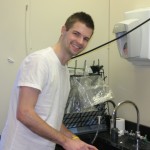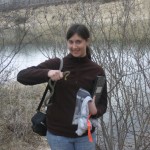The lab is pleased to welcome three new research students who have joined the team for the coming year.
Luke Andrew is a sophomore biology major from Enumclaw, WA who will be working on various projects examining hummingbird response to climate change (funded by NASA).For the next year most of Luke’s work will be focused on developing protocols for measuring field energetics that can be used in the field. Luke’s first task will be to develop a reliable technique for collecting urine samples from hummingbirds that can be used as a body-water source for doubly-labeled water analysis which is used to measure field metabolic rate. Luke’s work this next will be funded by the Richter Scholar Program here at George Fox University.
Katie Langland is a junior biology major from Redmond, OR who will split her time between two lab projects. She will conduct a study on the role female body temperature plays in courtship decisions made by male red-sided garter snakes (Thamnophis sirtalis parietals) in Manitoba, Canada. Katie will also take charge of developing protocols for measurement of nighttime body temperatures in hummingbird using the lab’s new FLIR SC6700 Infrared Camera.
Finally, Elliott Davis, a junior biology major from Canby, Or, will continue work done in the lab the past several years on thedistribution and regulation of aquaporin water channels in the ventral skin of rough-skinned newts (Taricha granulosa). Elliott will continue to explore how localized distribution of aquaporins 1-4 change in newts acclimated to aquatic vs. terrestrial conditions. Further, we have acquired some Plethodontid salamanders (Plethodon shermanii) that will allow Elliott to explore differences in aquaporin management in a primarily aquatic (Taricha) vs. exclusively terrestrial (Plethodon) species. Elliott will also be funded by the Richter Scholar Program.











